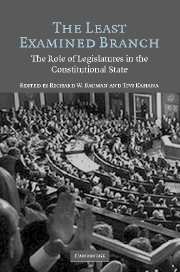Book contents
- Frontmatter
- Contents
- Foreword: Legislatures in the Constitutional State by Amy Gutmann
- Contributors
- New Ways of Looking at Old Institutions
- PART ONE LEGISLATURES AND DEMOCRATIC THEORY
- PART TWO LEGISLATING AND DELIBERATING IN THE DEMOCRATIC LEGISLATURE
- PART THREE CONSTITUTION MAKING BY LEGISLATURES: THE EXPLICIT VERSION
- PART FOUR CONSTITUTION MAKING BY LEGISLATURES: THE IMPLICIT VERSION
- PART FIVE CONSTITUTIONAL INTERPRETATION AND APPLICATION BY THE LEGISLATURE
- PART SIX IS LEGISLATIVE CONSTITUTIONALISM POSSIBLE?
- PART SEVEN THE LEGISLATURE IN DIALOGUE: DOMESTIC AND INTERNATIONAL CONTEXTS
- Index
New Ways of Looking at Old Institutions
Published online by Cambridge University Press: 06 August 2009
- Frontmatter
- Contents
- Foreword: Legislatures in the Constitutional State by Amy Gutmann
- Contributors
- New Ways of Looking at Old Institutions
- PART ONE LEGISLATURES AND DEMOCRATIC THEORY
- PART TWO LEGISLATING AND DELIBERATING IN THE DEMOCRATIC LEGISLATURE
- PART THREE CONSTITUTION MAKING BY LEGISLATURES: THE EXPLICIT VERSION
- PART FOUR CONSTITUTION MAKING BY LEGISLATURES: THE IMPLICIT VERSION
- PART FIVE CONSTITUTIONAL INTERPRETATION AND APPLICATION BY THE LEGISLATURE
- PART SIX IS LEGISLATIVE CONSTITUTIONALISM POSSIBLE?
- PART SEVEN THE LEGISLATURE IN DIALOGUE: DOMESTIC AND INTERNATIONAL CONTEXTS
- Index
Summary
This book seeks to redress an imbalance. Over the past few generations, scholars who study processes of constitutional lawmaking – including modes of creation, interpretation, and application – have focused largely on how courts work with constitutions. Rival theories of adjudication, whether dealing with how power is allocated in a modern state or with how rights are to be protected in light of constitutional guarantees, have been intricately constructed. Just as theories along this line have proliferated, so too have empirical studies of the performance of judges as constitutional oracles and referees.
Less attention has been paid to how legislatures, executive officials, or administrative agencies have interpreted their responsibilities to make or revise or implement constitutions. Of these branches, legislatures are the prime focus of this book. How do they respect (or occasionally overstep) constitutional boundaries? When and for what ends do they reverse the constitutional decisions of courts? How do legislatures create new forms of constitution-like instruments, doctrines, and principles? Moreover, how do they realize or make concrete the ideals that underpin a constitutional democracy? Are there discrepancies between what a constitution envisions by way of democratic processes or values and how legislatures operate in fact? In response to such questions, this book offers theoretical perspectives from a multidisciplinary group of authors. The work of legislatures, illustrated by examples derived predominantly from North America, is described as well as normatively assessed.
The systematic neglect of legislatures by legal and political philosophers has been noted by, among others, Jeremy Waldron.
- Type
- Chapter
- Information
- The Least Examined BranchThe Role of Legislatures in the Constitutional State, pp. 1 - 14Publisher: Cambridge University PressPrint publication year: 2006
- 1
- Cited by



